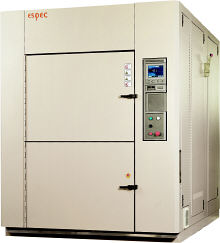ABOVE: A thermal shock chamber from ESPEC. This one is available with water cooling, air cooling, or liquid nitrogen cooling.
|
The refrigeration system of a chamber removes heat from the test specimen and its surrounding air -- this process reduces the temperature inside the chamber. The heat is transported through the refrigeration system to the condenser. In modern environmental test chambers there are basically two types of condensers: air-cooled or water-cooled. Each has its advantages and disadvantages. Most small chambers come are air cooled. Therefore, they simply need to be plugged into an electrical socket. This is an important feature when chamber portability is a must. Two disadvantages of air-cooled chambers: (1) Heat and noise release into surrounding area. Air-cooled chambers vent heat into their immediate environment so they may need to be located in air-conditioned areas. For instance, an air-cooled chamber with a two-horsepower cascade system operating at full load will introduce about 24,000 Btu/hour into its environment. When the chamber is at setpoint, it will output 12,000 to 15,000 Btu/hour into the room. In smaller rooms with air-cooled chambers in use, it's important that the air-conditioning system can handle the additional heat load. The heat output of an air-cooled chamber may be roughly estimated as follows: Horsepower of refrigeration system multiplied by 12,000 Btu/hour. If a chamber is going to be installed in an area that's not air-conditioned, tell the chamber manufacturer. The chamber may not work dependably if the ambient temperature regularly exceeds 29 °C to 32 °C. (2) Dirt Large amounts of air travel through the condenser while the system is operating. On most air-cooled systems the condensers are located near the floor,. Therefore, the condenser requires regular cleaning so that it can perform at top efficiency. If the chamber is located in an especially dirty environment, the condenser can become clogged quite quickly. Restricted airflow will cause the refrigeration system to run at high pressure, tripping the high-pressure safety. If this environment is to be ultimate location for your test chamber, an air-cooled system with a remote condenser or a water-cooled system should be considered. The air-cooled condenser is removed from the chamber and placed in another area, usually outdoors. Outwardly, a remote condenser (located outdoors) seems ideal since heat and noise are removed from the indoor environment. Unfortunately, this type of system is more complicated and expensive to install for many reasons:
Water-Cooled Chambers If your facility has access to process water (i.e. cooling water as in a tower/dry system; temp. between 5 and 30°C (41 to 85°F)), a water-cooled test chamber is a good alternative. Water-cooled units are usually easier to install and some models require less maintenance. If you go this route, consult with the chamber supplier/manufacturer for the water-flow and pressure requirements for any unit you are interested in. For example, pressure delta between the inlet and outlet should be 200 kPa (30 psi). The capacity of the process-water system should also be verified before selecting the test chamber. Water-cooled systems can run into problems because of insufficient water flow or differential water pressure supplied to the chamber. Another disadvantage is that they treatment of the water to prevent freezing (in cold weather) and various types of contamination.
|


